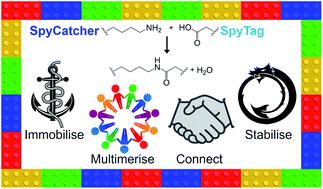当前位置:
X-MOL 学术
›
Chem. Sci.
›
论文详情
Our official English website, www.x-mol.net, welcomes your
feedback! (Note: you will need to create a separate account there.)
Power to the protein: enhancing and combining activities using the Spy toolbox
Chemical Science ( IF 7.6 ) Pub Date : 2020-07-03 , DOI: 10.1039/d0sc01878c Anthony H Keeble 1 , Mark Howarth 1
Chemical Science ( IF 7.6 ) Pub Date : 2020-07-03 , DOI: 10.1039/d0sc01878c Anthony H Keeble 1 , Mark Howarth 1
Affiliation

|
Proteins span an extraordinary range of shapes, sizes and functionalities. Therefore generic approaches are needed to overcome this diversity and stream-line protein analysis or application. Here we review SpyTag technology, now used in hundreds of publications or patents, and its potential for detecting and controlling protein behaviour. SpyTag forms a spontaneous and irreversible isopeptide bond upon binding its protein partner SpyCatcher, where both parts are genetically-encoded. New variants of this pair allow reaction at a rate approaching the diffusion limit, while reversible versions allow purification of SpyTagged proteins or tuned dynamic interaction inside cells. Anchoring of SpyTag-linked proteins has been established to diverse nanoparticles or surfaces, including gold, graphene and the air/water interface. SpyTag/SpyCatcher is mechanically stable, so is widely used for investigating protein folding and force sensitivity. A toolbox of scaffolds allows SpyTag-fusions to be assembled into defined multimers, from dimers to 180-mers, or unlimited 1D, 2D or 3D networks. Icosahedral multimers are being evaluated for vaccination against malaria, HIV and cancer. For enzymes, Spy technology has increased resilience, promoted substrate channelling, and assembled hydrogels for continuous flow biocatalysis. Combinatorial increase in functionality has been achieved through modular derivatisation of antibodies, light-emitting diodes or viral vectors. In living cells, SpyTag allowed imaging of protein trafficking, retargeting of CAR-T cell killing, investigation of heart contraction, and control of nucleosome position. The simple genetic encoding and rapid irreversible reaction provide diverse opportunities to enhance protein function. We describe limitations as well as future directions.
中文翻译:

蛋白质的力量:使用 Spy 工具箱增强和组合活动
蛋白质的形状、大小和功能多种多样。因此,需要通用方法来克服这种多样性并简化蛋白质分析或应用。在这里,我们回顾了 SpyTag 技术,该技术现已用于数百种出版物或专利,及其检测和控制蛋白质行为的潜力。 SpyTag 在与其蛋白质伴侣 SpyCatcher 结合后形成自发且不可逆的异肽键,其中两个部分均经过基因编码。该对的新变体允许以接近扩散极限的速率进行反应,而可逆版本则允许纯化 SpyTagged 蛋白质或调整细胞内的动态相互作用。 SpyTag 连接蛋白的锚定已建立在不同的纳米粒子或表面上,包括金、石墨烯和空气/水界面。 SpyTag/SpyCatcher 具有机械稳定性,因此广泛用于研究蛋白质折叠和力敏感性。支架工具箱允许将 SpyTag 融合组装成定义的多聚体,从二聚体到 180 聚体,或无限的 1D、2D 或 3D 网络。二十面体多聚体正在评估其针对疟疾、艾滋病毒和癌症的疫苗接种效果。对于酶,Spy 技术提高了弹性,促进了底物通道,并组装了水凝胶以进行连续流动生物催化。通过抗体、发光二极管或病毒载体的模块化衍生化,实现了功能的组合增加。在活细胞中,SpyTag 可以对蛋白质运输进行成像、CAR-T 细胞杀伤的重新定位、心脏收缩的研究以及核小体位置的控制。简单的基因编码和快速的不可逆反应为增强蛋白质功能提供了多种机会。 我们描述了局限性以及未来的方向。
更新日期:2020-07-22
中文翻译:

蛋白质的力量:使用 Spy 工具箱增强和组合活动
蛋白质的形状、大小和功能多种多样。因此,需要通用方法来克服这种多样性并简化蛋白质分析或应用。在这里,我们回顾了 SpyTag 技术,该技术现已用于数百种出版物或专利,及其检测和控制蛋白质行为的潜力。 SpyTag 在与其蛋白质伴侣 SpyCatcher 结合后形成自发且不可逆的异肽键,其中两个部分均经过基因编码。该对的新变体允许以接近扩散极限的速率进行反应,而可逆版本则允许纯化 SpyTagged 蛋白质或调整细胞内的动态相互作用。 SpyTag 连接蛋白的锚定已建立在不同的纳米粒子或表面上,包括金、石墨烯和空气/水界面。 SpyTag/SpyCatcher 具有机械稳定性,因此广泛用于研究蛋白质折叠和力敏感性。支架工具箱允许将 SpyTag 融合组装成定义的多聚体,从二聚体到 180 聚体,或无限的 1D、2D 或 3D 网络。二十面体多聚体正在评估其针对疟疾、艾滋病毒和癌症的疫苗接种效果。对于酶,Spy 技术提高了弹性,促进了底物通道,并组装了水凝胶以进行连续流动生物催化。通过抗体、发光二极管或病毒载体的模块化衍生化,实现了功能的组合增加。在活细胞中,SpyTag 可以对蛋白质运输进行成像、CAR-T 细胞杀伤的重新定位、心脏收缩的研究以及核小体位置的控制。简单的基因编码和快速的不可逆反应为增强蛋白质功能提供了多种机会。 我们描述了局限性以及未来的方向。











































 京公网安备 11010802027423号
京公网安备 11010802027423号